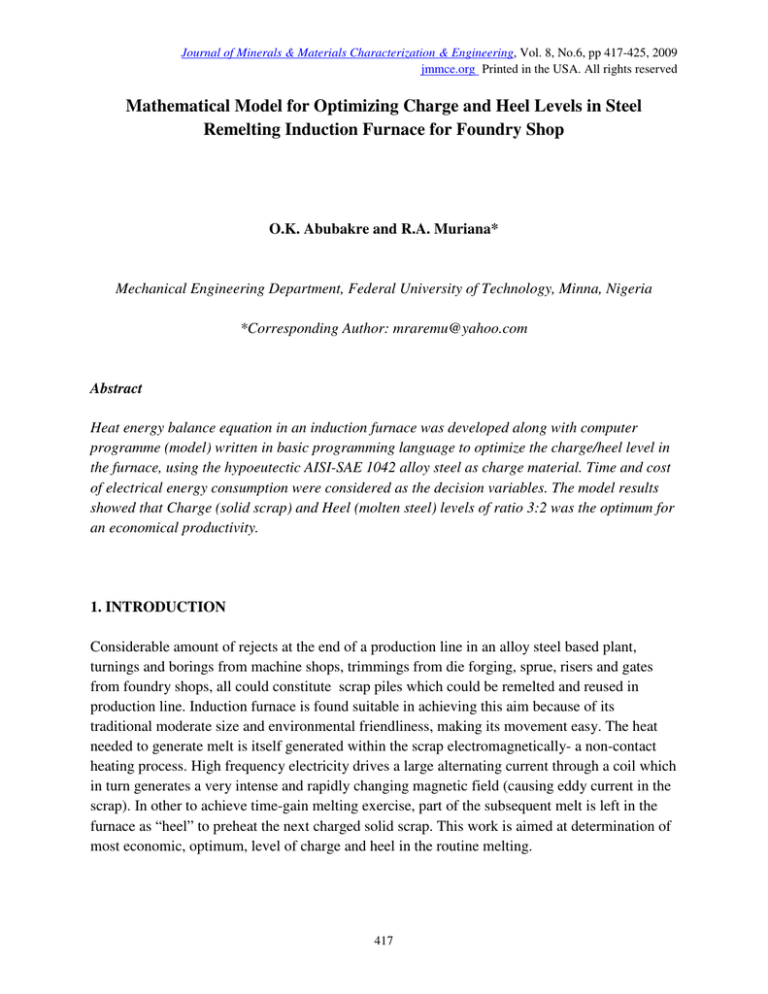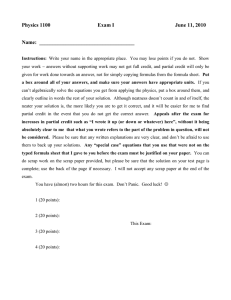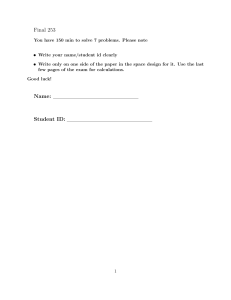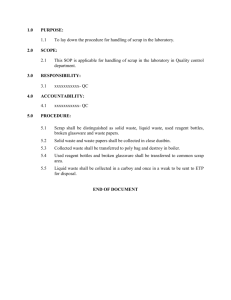
Journal of Minerals & Materials Characterization & Engineering, Vol. 8, No.6, pp 417-425, 2009
jmmce.org Printed in the USA. All rights reserved
Mathematical Model for Optimizing Charge and Heel Levels in Steel
Remelting Induction Furnace for Foundry Shop
O.K. Abubakre and R.A. Muriana*
Mechanical Engineering Department, Federal University of Technology, Minna, Nigeria
*Corresponding Author: mraremu@yahoo.com
Abstract
Heat energy balance equation in an induction furnace was developed along with computer
programme (model) written in basic programming language to optimize the charge/heel level in
the furnace, using the hypoeutectic AISI-SAE 1042 alloy steel as charge material. Time and cost
of electrical energy consumption were considered as the decision variables. The model results
showed that Charge (solid scrap) and Heel (molten steel) levels of ratio 3:2 was the optimum for
an economical productivity.
1. INTRODUCTION
Considerable amount of rejects at the end of a production line in an alloy steel based plant,
turnings and borings from machine shops, trimmings from die forging, sprue, risers and gates
from foundry shops, all could constitute scrap piles which could be remelted and reused in
production line. Induction furnace is found suitable in achieving this aim because of its
traditional moderate size and environmental friendliness, making its movement easy. The heat
needed to generate melt is itself generated within the scrap electromagnetically- a non-contact
heating process. High frequency electricity drives a large alternating current through a coil which
in turn generates a very intense and rapidly changing magnetic field (causing eddy current in the
scrap). In other to achieve time-gain melting exercise, part of the subsequent melt is left in the
furnace as “heel” to preheat the next charged solid scrap. This work is aimed at determination of
most economic, optimum, level of charge and heel in the routine melting.
417
418
O.K. Abubakre and R.A. Muriana
Vol.8, No.6
1.1. Literature Review
1.1.1. Electromagnetic induction heating
Induction heating is mainly dependent on two physical phenomena:
1.
Faraday-Lenz’s law and
2.
The Joule effect
When loop of a conductor is placed in an alternating magnetic field, alternating current is
induced in the loop thus
dΦ
E=
(1)
dt
Where E = voltage (v)
Φ = magnetic flux (wb)
t = time (s)
Faraday affirmed that when this loop is short-circuited, the induced voltage ‘E’ will cause
current to flow and oppose its cause, the alternating magnetic field. If a massive conductor (like a
charged crucible) is placed in the alternating magnetic field, eddy current will be induced and in
turn, generate heat within the conductor according to the joule effect principle. [1]
1.1.2. The Joule effect
When current ‘I’ (A) flows through a conductor with resistance ‘R’ (Ω), power ‘p’ (w) is
dissipated in the conductor as [2]:
P = R x I2
1.1.3. Skin effect
A source of high frequency electricity is used to drive a large alternating current through the
coil. This coil is known as the work coil (Figure 1). The passage of current through this coil
generates a very intense and rapidly changing magnetic field in the space within the work coil.
The work piece to be heated is placed within this intense alternating magnetic field. The
alternating magnetic field induces a current flow in the conductive work piece. The arrangement
of the work coil and the work piece can be thought of as an electrical transformer. The work coil
is like the primary where electrical energy is fed in, and the work piece is like a single turn
secondary that is short-circuited. This causes tremendous currents to flow through the work
piece. These are known as eddy currents.(Figure 2). In addition to this, the high frequency used
in induction heating applications gives rise to a phenomenon called skin effect. This skin effect
forces the alternating current to flow in a thin layer towards the surface of the work piece. The
Vol.8, No.6
Mathematical Model for Optimizing Charge and Heel Levels
419
skin effect increases the effective resistance of the metal to the passage of the large current.
Therefore it greatly increases the heating effect caused by the current induced in the work piece.
So, the skin effect is characterized by a parameter called penetration depth (δ in mm) to estimate
the induced eddy current penetration depth. Maxwell’s equation gives δ as
δ = k ρµ f
r
(2)
Where ‘ρ’ = electrical resistivity (Ω.m)
µr = relative magnetic permeability (H/m)
f = frequency (Hz) and
k = proportionality constant (503 for steel) [3]
Figure 1. Skin effect demonstration on the surface of the heated
bolt(www.inductionheating.co.uk )
Figure 2: Eddy current concentrates on the surface of the work piece
420
O.K. Abubakre and R.A. Muriana
Vol.8, No.6
1.2. Induction Furnace Heat Generation
1.2.1. Heat generation rate in an induction furnace
The heat ‘Q’ in joule, generated in an induction furnace is directly proportion to the square of the
induced current ‘Is’ in Ampere, as shown in equation 3.
2
Q = Z I s ( µr ρ f ) •t
(3)
Heat generation rate is therefore given by
Q
t
where Z = an empirical constant [4].
The induction furnace arrangement behaves likes a transformer. The work coil is likened to the
primary winding while the charge serves as secondary winding [5].
1.2.2. The Heat (Hs) needed to melts solid scrap of mass ms in Kg and raise the melt
temperature from ambient temperature to a superheat temperature θs in oC.
Heat Hs shall be the addition of heat to raise the scrap’s temperature from ambient temperature to
its melting point, heat needed to change the solid scrap to liquid at the same temperature and the
heat needed to raise the temperature of the melt from melting point to a given superheat
temperature. Thus,
H s = m s C (θ m − θ ) + m s L + m s C (θ s − θ m )
(4)
Where C = specific heat capacity of the scrap material in ….
θ m = melting point of the scrap material
θ = ambient temperature
The heat contents of heel and the mixture (solid scrap and heel) are connoted as Hh and Hmx
respectively (equation 5 and 6)
H h = m h C θ m + m h L + mh C (θ s − θ m )
(5)
Vol.8, No.6
Mathematical Model for Optimizing Charge and Heel Levels
H mx = (m s + mh )Cθ mx
421
(6)
(The resulting mixture is assumed to be is solid form, else the model does not apply).
Similarly, Hmx can be written as
H mx = m s Cθ + m h C θ m + mh L + m h C (θ s − θ m )
Then,
θ mx =
m s C θ + m h L + m h Cθ s
C (mh + ms )
(7)
Where θmx = mixture’s temperature.
The crucible effective mass meff = ms + mh.
2. THE MODEL EQUATIONS
Assumptions:
1.
Heat loss during opening and closing of the furnace is neglected
2.
The heat absorbed by the crucible (during the first melting) is not accounted for.
To have a complete melt from the scrap, the inductive heat generated by the furnace must be
equal to the heat needed to melt the scrap.
Therefore, Q = Hs.
That is,
2
Z I s ( µr ρ f ) •t =
m s C (θ m − θ ) + m s L + m s C (θ s − θ m )
(8)
And
t=
m s C (θ m − θ ) + m s L + m s C (θ s − θ m )
2
ZI s ( µ r ρ f )
(9)
3. THE MODEL PROGRAM
CLS
10 REM “MODEL PROGRAMME FOR OPTIMIZING SCRAP –HEEL LEVEL
IN
STEEL REMELTING INDUCTION FURNACE USING STEEL GRADE
AISI-SAE
1042 AS THE CHARGE MATERIAL
422
O.K. Abubakre and R.A. Muriana
Vol.8, No.6
20 DIM Mheel(200), Mscrap(200),Tmx(200),Qm(200), COSTs(200),COSTh(200),G(200),Thr(200)
35 DIM Q1(200), Q2(200), Q3(200),Cs(200),Ct(200),Ch(200),Csh(200),COSTs1Kg(200)
40 DIM COSTh1Kg (200), COSTmelt (200), G (200), J (200), Pp (200), NS (200), LS(200)
50 REM “ρS” IS CHARGE MATERIAL DENSITY; “Vcru” AND “Veff” ARE TOTAL AND
EFFECTIVE VOLUMES IN RESPECTIVELY
55 REM “Meff IS EFFECTIVE MASS OF CHARGE”
60 INPUT “CHARGE DENSITY =” ; ρS
70 Vcru = 0.003825: Veff = (3/4)*Vcru : Meff = ρal* Veff
75 PRINT “EFFECTIVE MASS = “ ; Meff
a$ = INPUT$(1)
80 REM “C” IS SPECIFIC HEAT CAPACITY OF THE STEEL; “L” IS LATENT
HEAT
OF FUSION OF THE STEEL AS WELL”
90 REM “T amb” IS THE AMBIENT TEMPERATURE; “Tm” IS MELTING POINT OF THE
ALLOY (THE STEEL); AND“Ts”IS THE SUPERHEATTEMPERATURE
100 INPUT “C=”; C
105 INPUT “L” ; L
110 INPUT “Tamb=”; Tamb
115 INPUT “Ts=”; Ts
120 REM “IP” IS THE SUPPLIED CURRENT IN AMP. ; “VP”IS THE SUPPLIED
VOLTAGE IN VOLT AND “µr” THE ALLOY’S RELATIVE MAGNETIC
PERMIABILITY,“F”IS FREQUENCY AND“LS”IS THE INDUCED
CURRENT
125 IP = 16.3: VP = 170: µr =180: F = 50: KT = 0.0013
130 REM HEEL RANGES FROM 10% TO 50% STEP 5 WHILE SCRAP RANGES
FROM
90% TO 50% STEP 5
135 REM “Rsc” IS SCRAP RANGE; “Rheel” IS HEEL RANGE; “Mheel” IS MASS OF
HEEL;
“Mscrap” IS MASS OF SCRAP
a$ = INPUT$(1)
140 I=1
145 Rsc = 0.9
150 FOR Rheel = 0.1 TO 0.50 STEP 0.05
155 Mheel = Meff * Rheel
160 Mscrap = Meff *Rsc
165 Q1 = Mscrap *C* Tamb
170 Q2 = Mheel * L
175 Q3 = Mheel *C * Ts
180 Tmx = (Q1+Q2 +Q3)/ (C * Meff)
185 G = KT* (LS) ^2
205
IF Tmx >200 AND Tmx < 250 THEN PC = 0.296 ELSE
IF Tmx >250 AND Tmx < 350 THEN PC = 0.301 ELSE
IF Tmx >350 AND Tmx < 400 THEN PC = 0.493 ELSE
Vol.8, No.6
Mathematical Model for Optimizing Charge and Heel Levels
IF Tmx >400 AND Tmx < 500 THEN PC = 0.638 ELSE
IF Tmx >500 AND Tmx < 600 THEN PC = 0.739 ELSE
IF Tmx >600 AND Tmx < 700 THEN PC = 0.894 ELSE
IF Tmx >700 AND Tmx < 800 THEN PC = 1.06 ELSE
IF Tmx >800 AND Tmx < 900 THEN PC = 1.093 ELSE
IF Tmx >900 AND Tmx < 1000 THEN PC = 1.11 ELSE
IF Tmx >1000 AND Tmx < 1100 THEN PC = 1.142 ELSE
IF Tmx >1100 AND Tmx <1200 THEN PC = 1.169 ELSE 295
a$= INPUT$(1)
208 J = (µr * PC* F ) ^ 0.5
210 Pp = G*J
213 t = ((Mscrap*C*1350) + (Mscrap *L) + (Mscrap*C*125))/Pp
215 REM “Thr IS THE TIME REQUIRED IN HOUR TO MELT THE SCRAP”
220 Thr = t / 3600
225 REM “NEPArate IS COST IN NAIRA PER KWh”
230 REM “Qm IS THE ENERGY USEDE TO MELT SCRAP IN KILOWATT”
235 Qm = (Ip * Vp *Thr )/1000
240 NEPArate = 6
245 REM “COSTs” IS OF MELTING SCRAP
250 COSTS = 6 * Qm
255 COSTs1Kg = COSTs/Mscrap
260 PRINT “COST OF MELTIN 1Kg SCRAP”; “=”; COSTs1Kg
265 PRINT “MASS OF SCRAP IN Kg=”;Mscrap
270 PRINT “MASS OF HEEL IN Kg=”;Mheel
275 PRINT “TIME TAKEN TO MELT THE SCRAP IN HOUR=”; Thr
280 PRINTS “TEMP. OF THE CHARGE Tmx IN DEGREE CELCIUS = ”; Tmx
283 I=I+1
285 Rsc =Rsc – 0.5
289 PRINT “
”
290 NEXT Rheel
a$=INPUT$(1)
295 END
RUN
COST OF MELTING 1Kg SCRAP = 0.88
MASS OF SCRAP IN Kg = 19.1
MASS OF HEEL IN Kg = 3.38
TIME TAKEN TO MELT THE SCRAP IN HOUR = 1.01
TEMP. OF THE CHARGE Tmx IN DEGREE CELCIUS = 301.93
423
424
O.K. Abubakre and R.A. Muriana
COST OF MELTING 1Kg SCRAP = 0.69
MASS OF SCRAP IN Kg = 18.0
MASS OF HEEL IN Kg = 4.5
TIME TAKEN TO MELT THE SCRAP IN HOUR = 0.75
TEMP. OF THE CHARGE Tmx IN DEGREE CELCIUS = 394.24
4. EXPERIMENTAL PROCEDURE
• Scrap was sourced locally, sorted and weighed in different quantities
● First charging for initial heel-gain
● Sequential charge melting
● Furnace clean up and turning off.
( Yusuf, 1998 )
5. RESULTS AND DISCUSSION
5.1. Model Result
The induction furnace model result is presented in Table 1.
Table 1: model results.
SN
Mscrap(Kg)
Mheel(Kg
COST, 1Kg
SCRAP(N)
1
2
3
4
5
6
7
8
20.25
19.13
18.00
16.88
15.75
14.63
13.50
12.38
2.50
3.38
4.50
5.63
6.75
7.87
9.00
10.13
0.89
0.88
0.69
0.61
0.56
0.51
0.47
0.46
5.2. Experimental Results
The experimental result is presented in Figure 3.
TIME TO
MELT
Mscrap(Hr)
1.08
1.02
0.75
0.62
0.53
0.45
0.38
0.35
Vol.8, No.6
Vol.8, No.6
Mathematical Model for Optimizing Charge and Heel Levels
425
Productivity (Kg/min)
13.00
12.95
12.90
12.85
12.80
12.75
0
10
20
30
40
50
60
Percentage Heel
Figure 3. Percentage Heel against Productivity
5.3. Results Discussion
The productivity increased with increase in heel level. Above 36.8% heel level however, a steep
decline in productivity set in (Figure 3). From the model result (table4.1), increase in heel level
up to 9.00Kg caused remarkable reduction in energy-cost of melting. Further increase above this
level however caused no significant reduction in energy-cost of melting.
6. CONCLUSION
Optimum range of melting the medium carbon steel in term of charge/heel ratio is between 3: 2
and 6.3: 3.7 by mass.
REFERENCES
1.
2.
3.
4.
5.
6.
Callebant L. (2007) “Induction Heating”. Pp2-9. www.induction .com.
Theraja B.L. and Theraja A.K. (2002) “Electrical Technology” S.chand New Delhi.
926pp;Pp1479-1490
Sybil P.P., Jonathan W. and Betty R. (1982) “Encyclopedia of Science and
Technology” Mc Graw-Hill New York 608pp, vol 3; 432pp vol 12
Rock H. (2003) “Induction Heating Plus” Thermal corporate, Pp1-3
www.inductionheating.co.uk
Yusuf J.A. (1998) “investigation on the effect of cold charge and heel on the
productivity of foundry furnace and effect on the quality of product” Pp6-28



![You`re invited to celebrate [child`s name]`s birthday at SCRAP! What](http://s3.studylib.net/store/data/007177272_1-c15601fb9e11b26854f13f1982e634e8-300x300.png)



